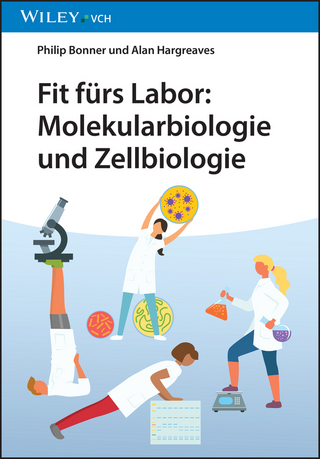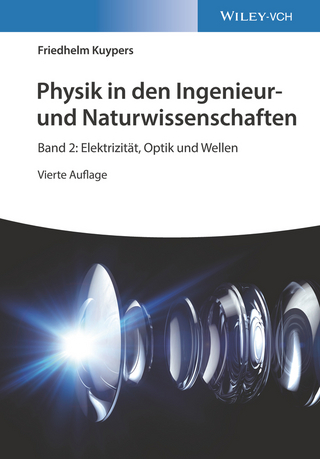
Live Cell Assays
ISTE Ltd and John Wiley & Sons Inc (Verlag)
978-1-84821-858-1 (ISBN)
Based on the recent explosion of knowledge in cell biology, the measurement of living cells represents a new class of industry-oriented research tests, the applications of which continue to multiply (pharmaceuticals, cosmetics, environment, etc.). Cellular tests are now being positioned as new tools at the interface between chemical methods, which are often obsolete and not very informative, and methods using animal models, which are expensive, do not fit with human data and are widely discussed from an ethical perspective. Finally, the development of cell assays is currently being strengthened by their being put into regulatory application, particularly in Europe through the REACH (Registration, Evaluation, Authorisation and Restriction of Chemicals) and cosmetic directives.
Christophe Furger is a cell biologist, Doctor of Pierre et Marie Curie University (Sorbonne Universities, Paris, France) and Director of Research and Development at L.E.D. He has been working since 1995 on the conception of cell assays. He currently heads a public/private research program in toxicity at the LAAS/CNRS lab (Toulouse, France).
Foreword xiii
Acknowledgments xix
Abbreviations xxi
List of Cell Assays xxiii
Introduction xxvii
Chapter 1. Principles and Position 1
1.1. Live cell assay principles 1
1.2. Application areas 3
1.3. Positioning 5
1.3.1. Definition and typology of cell tests 6
1.3.2. The regulatory and industrial dimension 8
1.4. Market 9
1.5. Competitive advantages 12
1.5.1. Cells are live information models 12
1.5.2. Development: high throughput 13
1.5.3. Development: multiplex analysis 13
1.5.4. Development: miniaturization 14
1.5.5. Development: molecular engineering 14
1.5.6. Development: standardization 14
1.6. Can measurements of cells in culture be extrapolated to effects in the organism? 15
1.6.1. Toxicokinetics 15
1.6.2. Components of the immune system 16
1.6.3. Biotransformation 16
1.6.4. The macrocellular environment 16
1.7. Limits 17
1.7.1. Importance of cellular microenvironment 17
1.7.2. Other limits 19
Chapter 2. History and State of the Art 21
2.1. Origins of cell culture 21
2.1.1. Pioneering studies 22
2.1.2. Alexis Carrel 23
2.1.3. Were Dr Carrel’s cells immortal? 25
2.2. The HeLa line and the first applications of cell culture 27
2.2.1. A vaccine against poliomyelitis 29
2.2.2. Cells in space 29
2.2.3. Cell cloning 30
2.3. New cell lines 30
2.3.1. The CHO line 30
2.3.2. An increasing number of cell lines 31
2.4. Cross-contamination 32
2.5. Cell lines, an ethical issue 35
2.6. The first generation of cell assays (1969–1983) 37
2.6.1. The karyotype test 38
2.6.2. The MTT assay 39
2.6.3. The NRU test 41
2.7. The first target of regulatory assays: genotoxicity (1983–1986) 42
2.7.1. Ames test (OECD guideline 471) 43
2.7.2. In vitro mammalian chromosome aberration test (OECD guideline 473) 44
2.7.3. In vitro mammalian cell gene mutation test (OECD guideline 476) 45
2.7.4. In vitro sister chromatid exchange assay in mammalian cells (OECD guideline no. 479) 46
2.7.5. DNA damage and repair, unscheduled DNA synthesis in mammalian cells (OECD guideline 482) 47
Chapter 3. Cell Models and Technologies 49
3.1. Fluorescence and bioluminescence 50
3.1.1. Green fluorescent protein 51
3.1.2. BRET 53
3.1.3. FRET 55
3.1.4. Other applications of GFP 57
3.1.5. The reporter gene approach 58
3.2. Impedance variation in cell population 60
3.3. Optical signals modified by state of cells 62
3.4. Cellular autofluorescence 65
3.4.1. The case of chlorophyll 66
3.5. The different cell models and culture modes available 67
3.5.1. Immortalized lines 68
3.5.2. Primary cells 69
3.5.3. Three-dimensional cell culture 69
Chapter 4. Loss of Cell Homeostasis: Applications in Toxicity Measurement 71
4.1. What relevant information to use in the living cell? 71
4.2. Lysosomal activity 73
4.3. Redox balance and oxidative stress 76
4.4. Integrity of the plasma membrane 80
4.5. Cellular efflux 84
4.6. Homeostasis of ion exchanges 89
4.6.1. The calcium ion 89
4.6.2. Maintenance of membrane potential 91
4.7. Metabolism and cell respiratory activity 92
4.8. Genotoxicity 95
4.9. Apoptosis 97
Chapter 5. The Replacement of Animal Testing: A Driving Force in Live Cell Assay Development 103
5.1. On the pertinence of in vitro assays 104
5.2. On the pertinence of animal tests 105
5.3. The problem with extrapolation 106
5.3.1. The interspecies barrier 106
5.3.2. The striking example of TGN1412 107
5.4. Toxicological assessment of substances 109
5.5. Irritation and eye corrosion: the long (ongoing) quest for an alternative to the Draize test 111
5.5.1. The CM test 112
5.5.2. Ex vivo approaches 113
5.5.3. 3D culture models 114
5.5.4. Recent attempts and validations 115
5.6. Measurement alternatives for skin absorption, corrosion and irritation (2004–2010) 116
5.6.1. Skin absorption: in vitro method (OECD guideline no. 428) 117
5.6.2. Reconstituted skin models for corrosion and irritation 117
5.6.3. In vitro skin corrosion: human skin model test (OECD guideline no. 431) 118
5.6.4. In vitro membrane barrier test method for skin corrosion (OECD guideline 435) 121
5.6.5. In vitro skin irritation: reconstructed human epidermis test method (OECD guideline no. 439) 121
5.7. The live cell test for phototoxicity measurement (2004) 122
5.8. Assays for endocrine disruptor tracking (2009–2011) 123
5.8.1. Detection of estrogenic agonist-activity of chemicals (OECD guideline 455) 124
5.8.2. H295R steroidogenesis assay (OECD guideline 456) 124
5.9. The four last live cell assays to be validated (2012–2015) 125
5.9.1. Eye corrosion: fluorescein leakage test method (OECD guideline 460) 125
5.9.2. Mammalian cell micronucleus test (OECD guideline 487) 126
5.9.3. ARE-Nrf2 luciferase test method for in vitro skin sensitization (OECD guideline no 442D) 127
5.9.4. Short-time exposure in vitro test method for identifying (1) chemicals inducing serious eye damage and (2) chemicals not requiring classification for eye irritation or serious eye damage (OECD guideline 491) 127
Chapter 6. Regulatory Applications and Validation 129
6.1. Brief history of the validation process in Europe 129
6.2. The validation process of a live cell assay 130
6.3. Live cell assays adopted by the OECD 132
6.4. The future of regulatory cell tests: the TOX21 and SEURAT programs 134
6.4.1. TOX21, a new paradigm in the assessment of health and environmental risks 134
6.4.2. The SEURAT-1 program (2011–2016) 138
6.5. The REACH regulatory context 139 6.5.1. Assessment approach by weight of evidence (WoE) 140
6.5.2. Up-date on the use of live cell assays under REACH 140
6.5.3. Acute toxicity 141
6.5.4. Skin corrosion and irritation 142
6.5.5. Eye irritation and severe damage 142
6.5.6. Skin sensitization 142
6.5.7. Repeated doses (long-term effects) 142
6.5.8. Genotoxicity 143
6.5.9. Reproductive toxicity (reprotoxicity) 143
6.5.10. Carcinogenicity 143
6.5.11. Bioaccumulation and toxicity in fish 144
6.5.12. Long-term toxicity and reprotoxicity in birds 144
6.6. Implementation of the 7th amendment to the Cosmetics Directive 144
6.6.1. Acute toxicity 145
6.6.2. Eye corrosion and irritation 145
6.6.3. Skin irritation and corrosion 146
6.6.4. Skin sensitization 146
6.6.5. Genotoxicity 147
6.6.6. Skin absorption 147
6.7. Food safety and biocides directive 147
6.7.1. Food safety 147
6.7.2. The biocides directive 148
Chapter 7. Cell Signaling: At the Heart of Functional Assays for Industrial Purposes 149
7.1. Membrane receptors, the primary target of drugs 149
7.1.1. Development of the therapeutic target/receptor concept 150
7.1.2. Purification, sequencing and heterologous expression 151
7.1.3. The therapeutic importance of seven transmembrane domain receptors 152
7.2. Second messenger, base unit of the functional live cell assay 153
7.2.1. The second messenger concept 153
7.2.2. Adenylyl cyclase and phosphodiesterase regulate the concentration of cyclic AMP 155
7.3. The concept of cell transduction 156
7.3.1. The protein kinase A, the (near) universal target of cyclic AMP 157
7.3.2. Decrypting the transduction pathways 158
7.3.4. G proteins, the missing link in cell transduction 160
7.3.5. Connection between transduction and genic expression 161
7.4. The transduction pathways used in the context of live cell assays 162
7.4.1. First level of regulation – activation of the transduction pathway 163
7.4.2. Second level of regulation – desensitization and recycling 164
7.4.3. Third level of regulation – allosteric modulation 165
Chapter 8. Applications in New Drug Discovery 167
8.1. High-throughput screening, the leading market sector for cell assays 167
8.1.1. The role of cell assays in screening programs 169
8.1.2. The contribution of functional cell assays 171
8.1.3. Exploitation of transduction pathways 171
8.2. Measurements in the immediate environment of receptors 173
8.2.1. Assays on receptors 173
8.2.2. β-arrestin activity assays 174
8.3. Measuring cyclic AMP 177
8.3.1. Classic cyclic AMP assays on cellular lysates 177
8.3.2. Cyclic AMP assays on live culture cells 180
8.4. Measurement of the PKC pathway and discrimination of the PKA/PKC pathways 183
8.4.1. IP3 measurement tests 183
8.4.2. Assays for the measurement of Ca2+ 183
8.4.3. Discrimination between the cyclic AMP and IP3/Ca2+ pathways by label-free methods 184
8.5. Measurement of distal signals 185
8.6. Cell assays concerning other therapeutic targets 186
8.6.1. Measurement on ion channels 186
8.6.2. Measurements on receptor tyrosine kinases (RTK) 188
8.7. Pharmacokinetics (ADME) in vitro 191
8.7.1. M for metabolism 192
8.7.2. A for absorption 193
8.7.3. T for toxicity 195
Chapter 9. Impact on Health and the Environment 197
9.1. Patient diagnosis 197
9.1.1. Cytogenetics 198
9.1.2. Diagnosis of tuberculosis 200
9.1.3. Cell assay for the detection of pyrogenic substances 201
9.1.4. Cell assays for predicting efficacy of chemotherapy 203
9.2. Military programs 204
9.2.1. Detection and screening of botulinum toxin inhibitors 205
9.2.2. Antibody-based toxin neutralization assays (TNA): application on anthrax and ricin 208
9.2.3. Field measurement of water potability 209
9.3. Pollution and quality of environment 211
9.3.1. The MicroTox assay 211
9.3.2. Mobility of the Daphnia test 212
9.3.3. Fish embryo acute toxicity (FET) test (OECD guideline no. 236) 213
9.3.4. The DR CALUX assay 214
9.3.5. Biomonitoring and field issues 215
Chapter 10. Outlook 219
10.1. Stem cells, an opportunity for the future of cell assays 219
10.2. Organs-on-a-chip 222
10.2.1. Homo chippiens 224
10.2.2. The contribution of PBPK models 225
10.3. Conclusion 226
Bibliography 229
Index 247
| Erscheinungsdatum | 04.06.2016 |
|---|---|
| Verlagsort | London |
| Sprache | englisch |
| Maße | 168 x 244 mm |
| Gewicht | 562 g |
| Themenwelt | Naturwissenschaften ► Biologie ► Allgemeines / Lexika |
| Naturwissenschaften ► Biologie ► Zellbiologie | |
| ISBN-10 | 1-84821-858-3 / 1848218583 |
| ISBN-13 | 978-1-84821-858-1 / 9781848218581 |
| Zustand | Neuware |
| Informationen gemäß Produktsicherheitsverordnung (GPSR) | |
| Haben Sie eine Frage zum Produkt? |
aus dem Bereich


